Unpacking Product-led, Marketing-led, and Sales-led Growth Strategies for SaaS
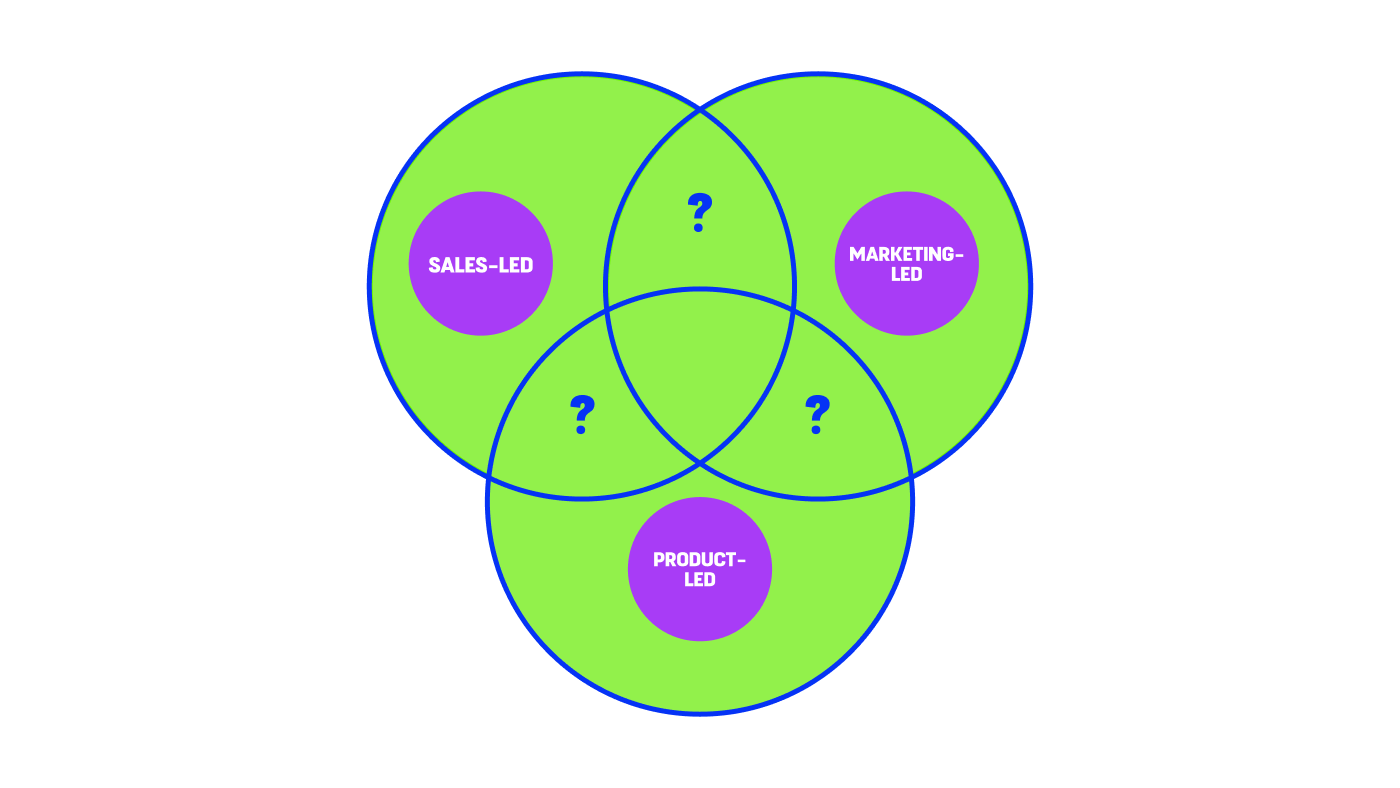
Product-led growth is everywhere. As a marketer who's also a PLG enthusiast, I get the hype.
But even I have to ask: is this the full picture?
Imagine if you ate nothing but broccoli for every meal. You'd be missing out on proteins, grains, and other essential nutrients. The same principle applies to your startup's growth strategy.
Relying solely on PLG – or any single growth strategy – can lead to a lopsided business. Experts caution against such a narrow view, emphasizing the need for a balanced approach that includes Marketing-led and Sales-led growth strategies as well.
So, consider me your business nutritionist for the day. We're going to break down the menu of growth strategies you can – and should – consider for your SaaS business.
By the end of this article, you'll be well equipped to make a balanced 'dietary' choice tailored to your startup's stage, product type, target market, and resources.
Let's dig in.
What is Growth?
Let's level-set for a moment.
Ask the question, "What is growth?" in a room full of folks from varying departments, and you'll get a smorgasbord of answers.
The sales team will tout customer acquisition; the marketing folks will wax poetic about brand equity, while product managers might veer into user engagement territory.
So let's cut through the noise to zero in on a definition most of us can nod our heads to.
Growth, in its most simplistic form, is the trifecta of acquiring, retaining, and monetizing customers. Or, to put it in a more formulaic way:
As a founder, your ultimate goal isn't just to pick a growth strategy that looks good on paper; it's to identify the one that actively helps you pull these three levers –Acquisition, Retention, and Monetization.
In this article, we're not pitting one growth strategy against another; instead, we're exploring how each one can serve as a different tool in your startup's growth toolbox.
Acquisition
Acquisition is the gateway to your product. Each growth approach – marketing-led, sales-led, and product-led – offers its own unique arsenal of acquisition tools. So, what does each bring to the table?
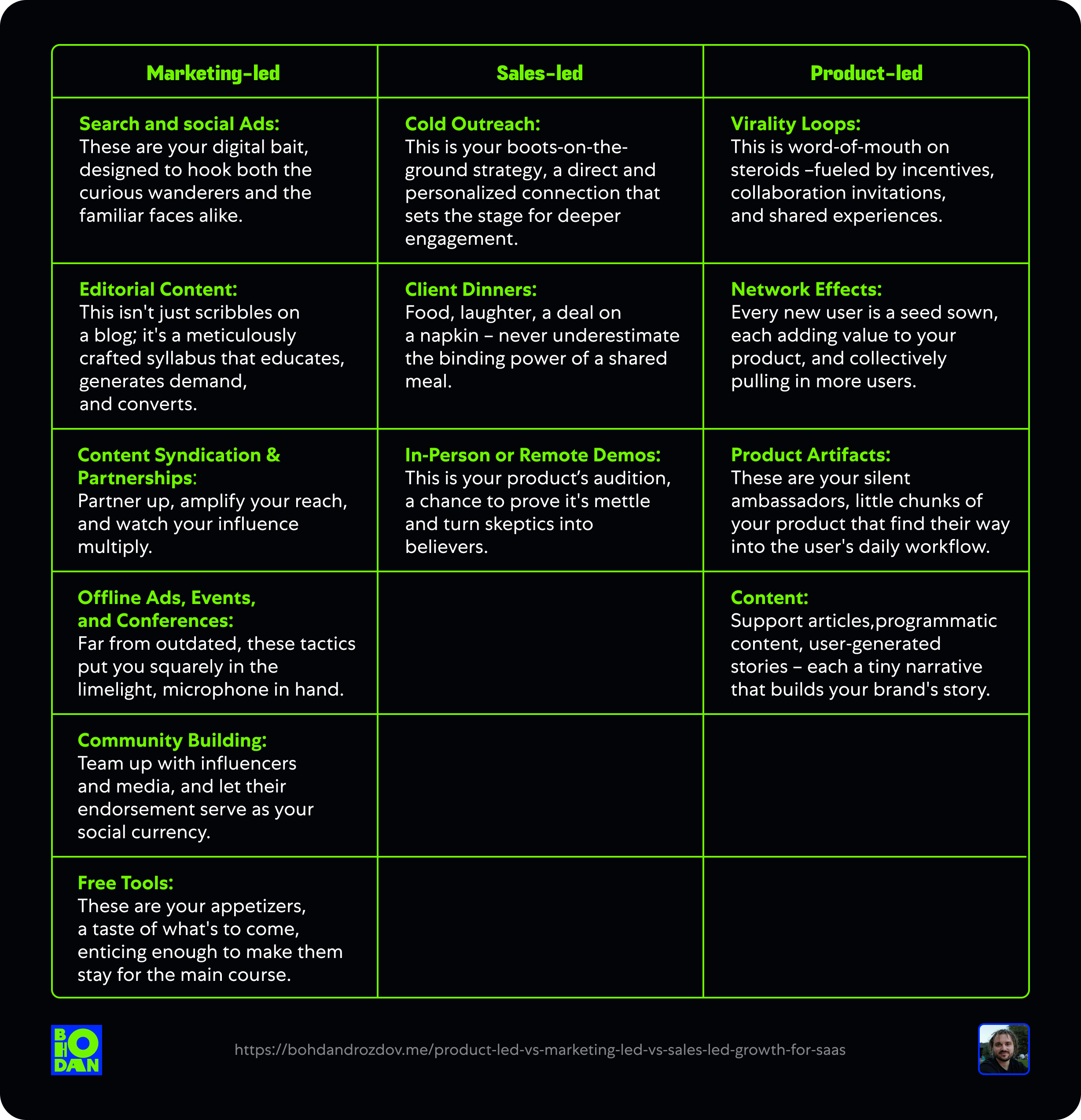
So, acquisition is your opener, the lead-off hitter setting the pace for the innings to come – retention and monetization.
Retention
Alright, you've got them in the door.
High five 🙏
But as any seasoned entrepreneur will tell you, acquisition is just the first date. Retention?
That's the long-term relationship, the Netflix series you can't stop binge-watching, the gym membership you actually use. So how does each approach help you keep the love alive?
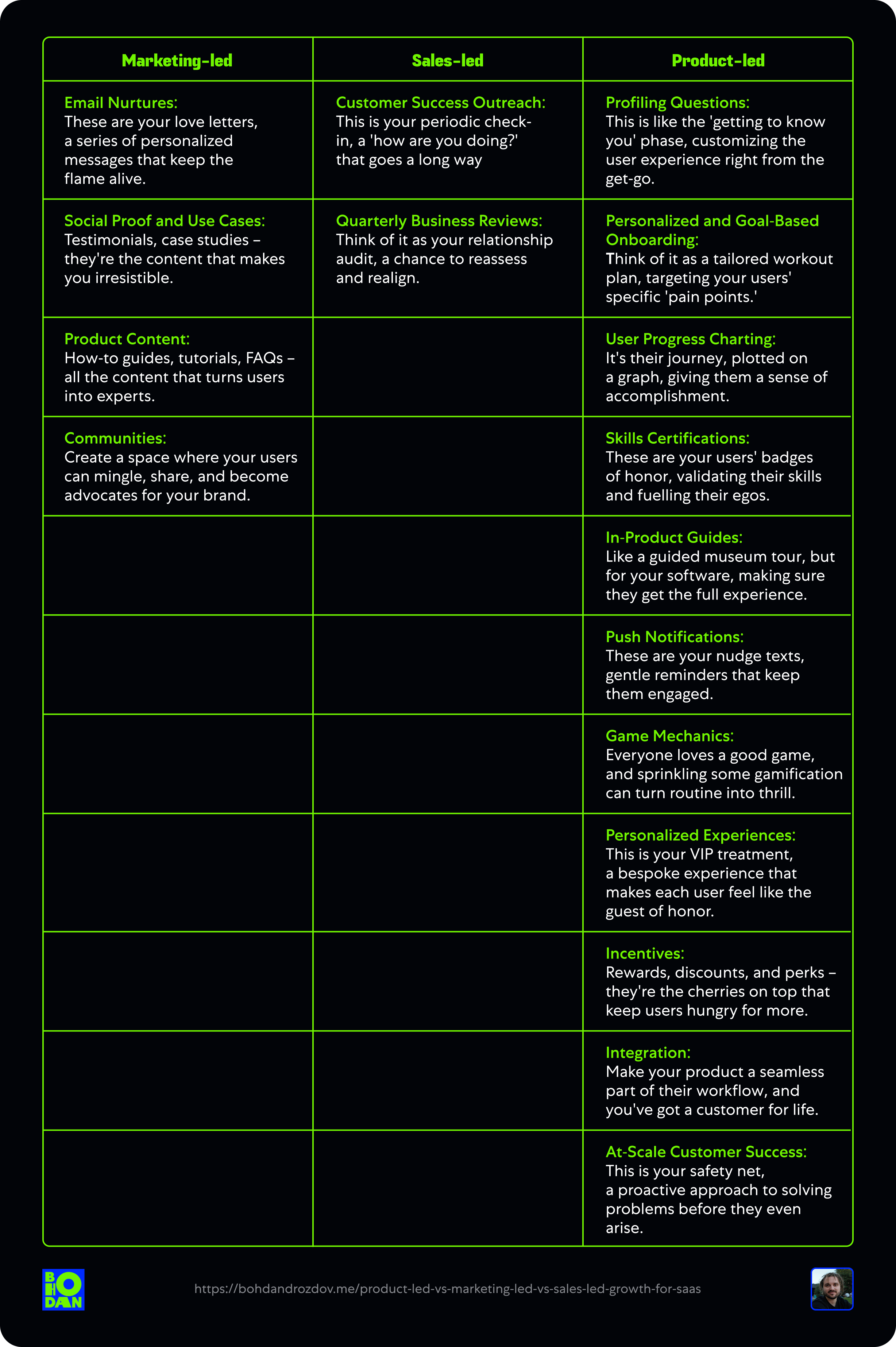
Retention isn't just about keeping customers; it's about evolving with them. It's the ongoing conversation, the endless updates, the perpetual relationship. Choose your tools wisely, and they won't just stay – they'll thrive.
Monetization
So, here we are at the finale, the third act, the last mile. You've acquired them, you've retained them, and now it's time to turn that goodwill into good money. If retention is the romantic getaway, monetization is the diamond ring.
How do you get them to say 'I do' with their wallets?
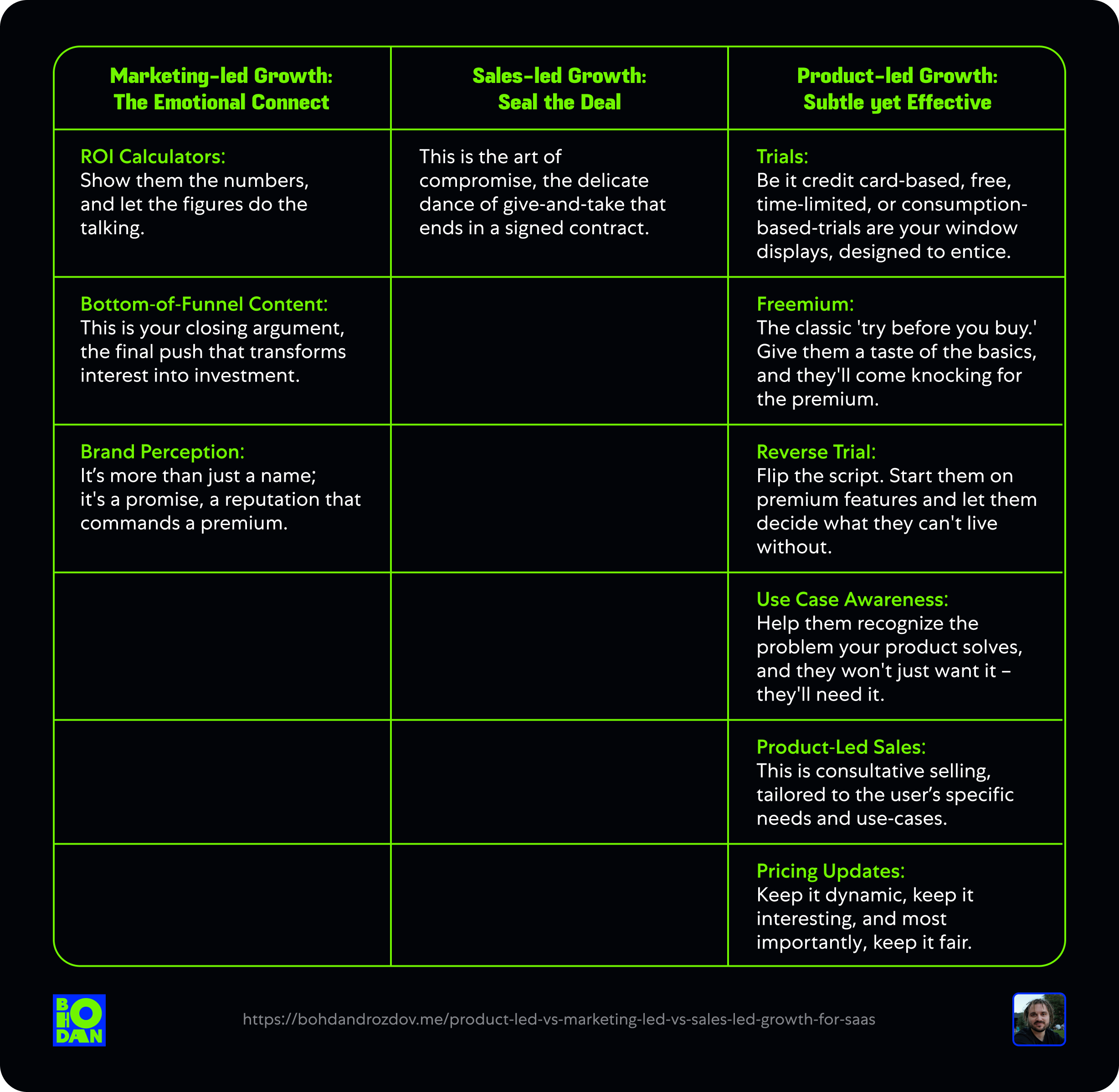
Monetization is the art of value exchange. It's not just about how much you charge, but how much they feel they're gaining.
Whether you're pulling levers in product, marketing, or sales, remember: Monetization is the final act that turns your startup story into a saga of success.
Choosing the right growth strategy for your SaaS
Navigating the labyrinth of early-stage B2B SaaS growth can be overwhelming.
To steer you through, here’s a roadmap tailored to your unique journey:
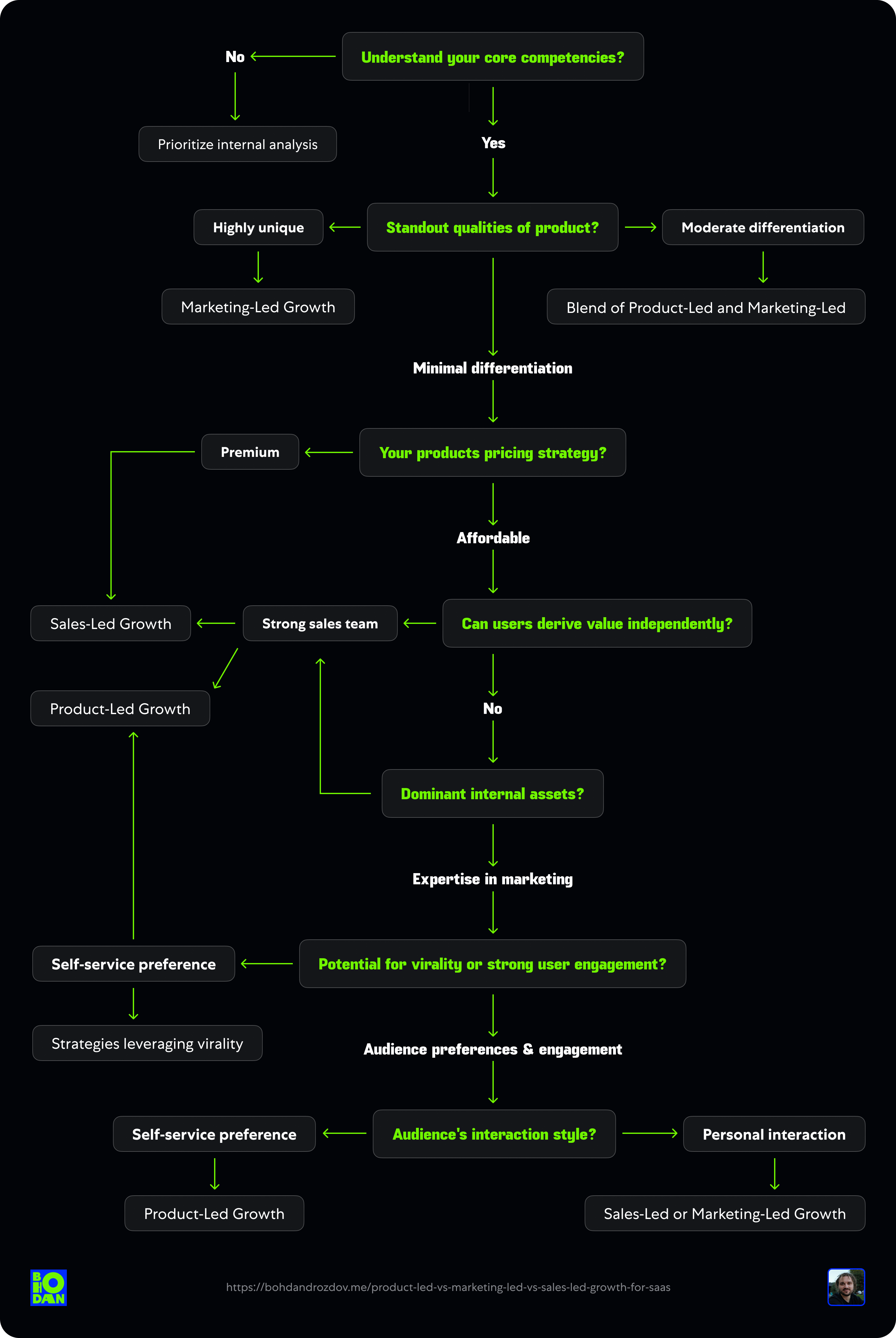
- Self-Reflection: Start by understanding your company's strengths and weaknesses. If your product promises groundbreaking innovation but you're still building your marketing prowess, lean into product-led growth initially.
- Product Differentiation: A standout product naturally gravitates towards marketing-led growth, leveraging its unique selling points. In contrast, a budding product that's still carving its niche might find value in a sales-led strategy, extracting priceless market insights and validation.
- User Autonomy: Does your product allow users to onboard, explore, and derive value seamlessly on their own? If yes, the product-led growth model might be your best ally.
- Budgetary Limitations: In the early days, every penny counts. Assess which growth strategy offers the best return on investment, harmonizing your financial constraints with growth ambitions.
- Engagement & Revenue: If higher user engagement directly boosts your revenue, focus on strategies that accentuate user value. A product-led growth model, in such scenarios, can be a game-changer.
- Audience Dynamics: Decode your target audience. If they're tech-savvy early adopters, they might prefer self-service tools. On the other hand, a segment craving personalized touchpoints will resonate more with a sales-led approach.
- Monetization Strategy: Reflect on your product's price point. A premium-priced offering can sustain a sales-led approach, given the higher revenue per conversion. Conversely, a modestly priced product might struggle to justify the costs of a sales-intensive strategy, making a product-led or marketing-led approach more feasible.
- The Power of Virality: While virality loops and network effects can supercharge growth, they aren't universal fits. Especially for products without collaborative elements, other growth avenues might be more fruitful.
- Internal Arsenal: Beyond finances, gauge your human capital. A formidable sales team? Sales-led growth beckons. A dynamic marketing team or a revolutionary product? Adjust your sails towards marketing-led or product-led growth, respectively.
- Sustaining Differentiation: In a market flooded with lookalikes, how long can your product wear its crown of uniqueness? Temporary differentiation might require bolstering through marketing-led strategies, ensuring your edge remains razor-sharp.
Examples: Putting this into Practice
When it comes to adopting a growth strategy, the reality is often more gray than black and white. Forget the one-size-fits-all mantras you've heard; let's dive into the realm of nuance through three fictional, yet palpably real, B2B SaaS startups.
MetricPulse
Industry: Marketing Tech
Product: A data analytics dashboard designed specifically for marketing agencies.
Ideal Customer Profile: Small to medium-sized marketing agencies with 10-50 employees specializing in digital advertising and looking to scale their analytics capabilities.
Hybrid Strategy: Enhanced Marketing-Led and Sales-Led for Acquisition, Sales-Led, Marketing-Led, and Product-Led for Retention, Product-Led for Monetization
Acquisition:
- Enhanced Marketing-Led: Think targeted SEO, in-depth PPC campaigns, industry reports, monthly webinars, and social media engagement.
- Sales-Led: Tailored outreach to agencies that engage but haven’t converted, offering customized demos.
Retention:
- Sales-Led: Personalized consultations and periodic business reviews.
- Marketing-Led: Curated email newsletters featuring actionable analytics tips and industry benchmarks.
- Product-Led: In-app nudges about new features and guided tutorials.
Monetization:
- Product-Led: A freemium model with prompts for premium features like predictive ROI calculations.
HRMaster
Industry: HR Tech
Product: An employee engagement and performance tracking tool designed for remote teams.
Ideal Customer Profile: HR managers and directors in remote-first or hybrid companies with 100-500 employees.
Hybrid Strategy: Sales-Led and Marketing-Led (with emphasis on MLG) for Acquisition, Product-Led, Sales-Led, and Marketing-Led for Retention, Product-Led and Sales-Led for Monetization
Acquisition:
- Sales-Led: Direct outreach to companies freshly transitioned to remote work.
- Marketing-Led (MLG Focus): A plethora of thought leadership content like webinars, trend analyses, and podcasts.
Retention:
- Product-Led: A dashboard that isn’t static but evolves based on user feedback.
- Sales-Led: Quarterly account manager check-ins.
- Marketing-Led: A monthly newsletter, not just for updates but for sharing best practices.
Monetization:
- Product-Led: In-app purchases for specialized modules like "Wellness Tracking."
- Sales-Led: Volume discounts for bulk purchases, because who doesn't love a good deal?
– Neha Goel Fractional CMO & Advisor for early-stage B2B SaaS in HR Tech
SalesMate
Industry: Sales Tech
Product: A Customer Relationship Management (CRM) tool designed for enterprise sales teams.
Ideal Customer Profile: Enterprise sales teams in the B2B SaaS space, with at least 50 sales reps.
Hybrid Strategy: Sales-Led and Marketing-Led for Acquisition, Product-Led, Sales-Led, and Marketing-Led for Retention, Product-Led and Sales-Led for Monetization.
Acquisition:
- Sales-Led: Identifying decision-makers through cold outreach and LinkedIn sleuthing.
- Marketing-Led: Whitepapers and case studies that do more than just sit on your desktop.
Retention:
- Product-Led: Analytics that tell you what you need to know, not just what you want to hear.
- Sales-Led: Quarterly reviews that are more conversation than sales pitch.
- Marketing-Led: Webinars and newsletters that actually add value.
Monetization:
- Product-Led: Tiered pricing that makes you think about scaling up, not just signing up.
- Sales-Led: Custom packages that feel like they were made just for you.
Wrapping it up: Navigating the growth maze
So, you've got the lowdown on marketing-led, product-led, and sales-led growth. No single strategy is the Holy Grail. Each comes with its own set of perks and pitfalls. But hey, who says you've got to pick just one? Variety is the spice of startup life.
- Stay Nimble, Stay Sharp: This isn't set in stone, folks. Your startup is a living, breathing entity. As you collect more data and feedback, don't hesitate to shake things up. Pivot, blend, iterate – that's the startup mantra.
- Show Me the Money: Different strategies have different appetites for cash and resources. Got a lean team but a killer product? Maybe product-led is your game. Got marketing chops to spare? Go marketing-led. Just remember to align those purse strings.
- Talk to Me: No matter the road you travel, keep that feedback loop wide open. Data is your co-pilot. Listen, adapt, and steer your way to better decision-making.
- Ask Experts: If you're in the early innings, some sage advice can go a long way. Seek out the gurus, the mavens, the wizards in your field. Their two cents might just be your goldmine.
- It's All About You, Customer: When the rubber meets the road, it's the customer who calls the shots. Solve their pain, and you've got yourself a win-win.
The trick is not to put all your eggs in one basket. The big leagues use a cocktail of these strategies. Why shouldn't you? So go ahead, mix and match, and build yourself a growth engine that's as unique as your startup.
